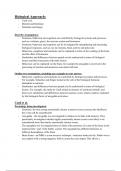Summary
Summary Cambridge International Examinations (CIE) Psychology Extremely Detailed Study Notes for the Biological Approach (Canli et al. ; Dement and Kleitman ; Schachter and Singer)
- Module
- Biological Approach
- Institution
- CIE
This document covers all the areas required on the 2022/2023 specification for the biological approach for CIE Psychology for the following studies: - Canli et al. (emotional experiences and the role of the amygdala) - Dement and Kleitman (sleep and dreams; REM and nREM) - Schachter and Singer ...
[Show more]



